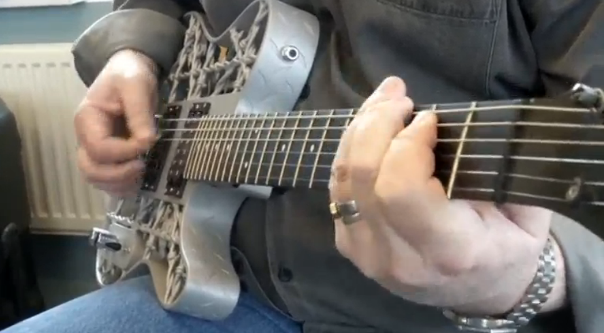
LUND, Sweden (Reuters) — A Swedish-based professor who became famous by pioneering the art of customised 3D printed instruments has unveiled his latest invention – a 3D-printed aluminium electric guitar.
Olaf Diegel, a professor at the University of Lund, has already made around 70 guitars using polyamide – a nylon powder – one of which is used by United States rock legends The Steve Miller Band.
But the New-Zealander was intrigued by the idea of using aluminium to create a truly ‘Heavy Metal’ instrument – although the resulting guitar is surprisingly lightweight. Using SolidWorks, a computer-aided design and computer aided engineering program, Diegel created a guitar decorated with barbed wire and roses, and had it printed by Dutch company Xilloc on an EOS M400 machine.
3D printing, also called additive manufacturing, involves making a three-dimensional object by adding ultra-thin layers of material one by one, following a digital design, in contrast to conventional manufacturing, where excess material is cut away.
Metal 3D-printing, which is becoming increasingly used to print parts in industries like aeronautics, is more challenging than using polyamide. Diegel thinks that using metal is the natural progression in his journey to persuade musicians to turn to 3D.
“You put a layer of metal powder down and a laser draws on the powder,” explained Diegel. “The laser melts the powder, but any bits that are overhanging need support material. The guitar has all these overhanging wires, filled with support material, to anchor the part to the build platform.”
After the guitar was welded to a steel plate, the supporting material had to be broken off. It then took four days of post-processing, including filing, sanding and polishing.
Diegel is delighted with the result and says 3D-printed guitars sound little different from traditional versions.
“Scientifically what makes a sound is the magnets on the pick-ups picking up the string vibrations. Anything that affects the vibrations will affect the sound to a very small extent, but because they are electric guitars they sound as good as any other electric guitar. Acoustic guitars would be a different story,” he explained.
Diegel says the advantage of 3D-printing guitars is that every guitar can be custom-made without it costing any more than if every guitar were the same.
Professional musician Tim Bricheno, once of 80s indie rock bands All About Eve and Sisters of Mercy, has reservations about the technology.
“The common misconception about electric guitars is that the wood is not important, it’s just down to the pick-ups that pick up the vibration of the strings. The fact is that anything that actually makes the guitar resonate will affect the way it sounds,” he said.
In 2014 Diegel teamed up with a four-piece band from Lund University’s Malmo Academy of Music who all used instruments he had 3D printed – including drums and a keyboard.
He now has his heart set on even more ambitious targets.
“For a few years I’ve been wanting to play with wind instruments because to me that’s where the real potential is, where you can split the wind and have the wind going over different cavities to make completely unique sound, such as a flute that plays chords.”








